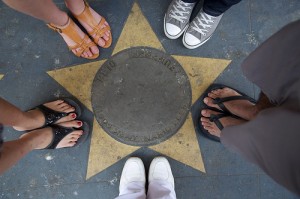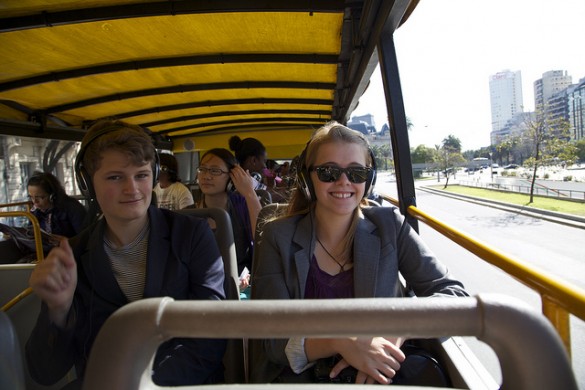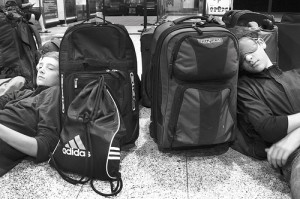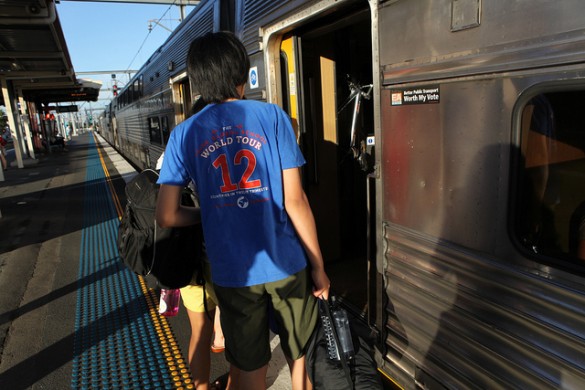1) Hi Nada, can you tell us what you've been up to since graduating from THINK Global School in 2022? Since graduating in 2022, I've been pursuing a passion I found while at TGS, sustainability, and I am currently majoring in engineering in renewable energy systems at Al Akhawayn University, in Ifrane, Morocco. But there is way more than that! I've had a chance also to explore the world of...
Read MoreTRAVELING AROUND THE WORLD requires the ability to, well, travel. However, I am not speaking to packing a suitcase carefully and leaving home. I am speaking to having access to modes of transportation. Our usage of some forms more than others is rather country-dependent, but here is a list of our more frequently used means. They have allowed us to immerse ourselves further in our various temporary homes, bringing us closer to being a local.
Our top 5 most commonly used modes of transportation, listed in order of frequency:
1. Feet
 TGS walks, and we walk just about everywhere. From walking to classes, to lunch, to dinner, to practice, to the market, on tours, or back to the residence, the list of where our feet take us goes on and on. Being located in the heart of Buenos Aires, we walk to any location that can be reached within a 20 to 30-minute stroll. Our feet see a lot of action throughout the semester, and proper footwear is a prized possession.
TGS walks, and we walk just about everywhere. From walking to classes, to lunch, to dinner, to practice, to the market, on tours, or back to the residence, the list of where our feet take us goes on and on. Being located in the heart of Buenos Aires, we walk to any location that can be reached within a 20 to 30-minute stroll. Our feet see a lot of action throughout the semester, and proper footwear is a prized possession.
We walk so much that I recall returning home for holiday and not realizing there were other options. I needed to run an errand and pick up something from a local store. I headed out the door, and it was not until I reached the end of my street that I stopped and starting laughing to myself. Walking to the places I needed to go had become such second nature that I had completely forgotten that driving a car was an option.
It is a great reminder that there is not always a need to get somewhere in 5 minutes when a 20-minute walk will do. It slows the pace of life down just a little bit.
2. Automobiles
Our most commonly used automobiles all look the same. Yellow and black, they prominently display the word “Taxi” somewhere on the exterior. If available for the taking, a bright red light exclaims “Libre” in the windshield. Taxis are a familiar necessity when walking is just too far or there is too much to carry. Using taxis has brought forth universal lessons to both students and staff alike:
- Always take well-marked taxis that are owned by whichever city’s more reputable company
- Take note of the driver’s licensing, which should be displayed somewhere in the car
- There should never be a problem in asking how much a trip should cost prior to getting into the car
- Be certain to ask to use the meter, if the driver does not automatically start it for you

3. Buses
Using both private and public buses is common practice for TGS. They are the most effective method of transporting mass amounts of people at once. With our numbers continuing to grow every year, the bus (or several of them) has become the reliable, predictable companion.
Students have been using the public bus system in Buenos Aires to get themselves around the city. The soccer team takes it to get to practice. Recently, students explored the city’s museums, using the bus system to take them from home, out, and back again. Learning the specifics of a location’s bus system helps in becoming more of a local–or at least appearing to be one. The public bus system in Buenos Aires has offered lessons in preparedness and prior research through:
- Having your change readily available as drivers keep a quick pace and you can only pay with change
- Knowing your destination beforehand, as buses do not always stop at predetermined locations
- Planning ahead because each route has several buses on it
- Knowing the exact bus number you want and signaling the driver when at the stop because they do not always pull over
4. Jumbo Jets
 Across the globe, there are innumerable amount of airports serving travelers. The top 30 busiest airports see over 64 million people annually. We have 52 individuals onsite who represent roughly 29 different countries, meaning a multitude of international flights stemming from all corners of the globe. It is a good thing that there are over 68* major airline carriers serving all our locales.
Across the globe, there are innumerable amount of airports serving travelers. The top 30 busiest airports see over 64 million people annually. We have 52 individuals onsite who represent roughly 29 different countries, meaning a multitude of international flights stemming from all corners of the globe. It is a good thing that there are over 68* major airline carriers serving all our locales.
It takes practice to ensure a smooth transition from check-in through security, to gate, and to take off. We have plenty of it. The frequency in which we are in airports throughout the year only further contributes to the growth of adaptability and resilience. Knowing ahead of time how to pack to meet various weight restrictions that change internationally, how much in liquid carry-ons allowed, and what items make flights easier take forethought and careful planning to avoid time-consuming snags.
[*Data based on 2011 provided by www.nationsonline.org] (Care to guess which airport is the world’s busiest?)5. Trains
Trains do not just mean traversing across countries and their borders. While they were the primary means of transportation during last year’s TGS Amazing Race, trains are more often utilized by local commuter rails and subway systems. Here in Buenos Aires alone, there are over 34,059 km (21,163 miles) of railroad tracks criss-crossing the city to bring some 445 million commuters to and from their destinations. Their rail system is extensive–second only to New York City’s in the USA–and boasts 259 different stations to get found in. This past weekend the students took advantage of the Tren de La Costa network to venture an hour north to Tigre for a day of exploration.

Learning to be a traveler means adapting to each city’s most efficient means of transportation. What works best in Boston or Berlin may not be the go-to choice in Buenos Aires. It takes a research and adaptability to successfully immerse in a locale’s travel culture, an important life lesson delivered daily.